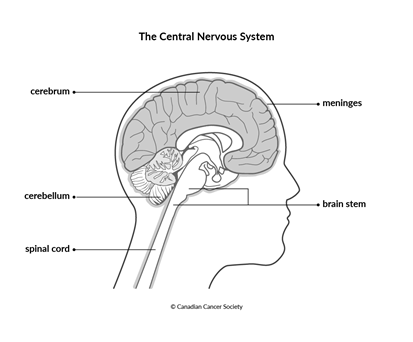What is a childhood brain or spinal cord tumour?
A brain tumour starts in the cells of the brain. A spinal cord tumour starts in the cells of the spinal cord. A brain or spinal cord tumour can also be called a central nervous system (CNS) tumour. The CNS is made up of the brain and the spinal cord. The brain is the control centre of your body. It is a soft mass of nerve tissue protected by a bony covering called the skull. The spinal cord runs through the spine. It contains nerves that send information between the brain and the rest of the body.

There are many types of childhood brain and spinal cord tumours. They can be non-cancerous (benign) or cancerous (malignant). Both cancerous and non-cancerous brain tumours can be life-threatening.
A cancerous tumour is a group of cancer cells that can grow out of control and spread to other parts of the body. A benign tumour will often grow more slowly and will not spread to other parts of the body. Although brain tumours rarely spread (metastasize) to other parts of the body, most brain tumours can spread throughout the brain and spinal cord tissue. Even non-cancerous brain tumours can grow, press on and destroy normal brain tissue.
Doctors often talk about a brain tumour rather than a brain cancer. In general, a cancerous brain tumour grows quicker and spreads through the rest of the brain faster than a non-cancerous brain tumour. Both non-cancerous and cancerous brain tumours can cause signs and symptoms and need treatment.
Describing childhood brain and spinal cord tumours
Brain and spinal cord tumours are classified based on their grade. The grade of a tumour tells you how quickly it is growing and how likely it is to spread.
Low-grade (benign) tumours grow slowly. They don’t usually grow into surrounding tissues or spread to other areas of the brain or spinal cord. Some low-grade tumours may develop into high-grade tumours.
High-grade (malignant) tumours grow quickly. They can grow into nearby tissues and spread to other parts of the brain or spine. Malignant tumours that start in the brain and spinal cord rarely spread outside the CNS.
Types of childhood brain and spinal cord tumours
Brain and spinal cord tumours are classified, or named, by the type of cell or tissue they start in.
Glia or glial cells support the neurons in the brain and spinal cord. Most brain and spinal cord tumours start from the glia. These are sometimes called gliomas. Gliomas include astrocytomas, ependymomas, brain stem gliomas and optic gliomas.
The most common types of brain and spinal cord tumours in children include:
- astrocytoma
- brain stem glioma
- choroid plexus tumours
- craniopharyngioma
- ependymoma
- germ cell tumours
- medulloblastoma
- optic and hypothalamic glioma
- rhabdoid tumour (also called teratoid tumour or atypical teratoid rhaboid tumour)
When a tumour starts in brain cells, it is called a primary brain tumour. Other types of cancer can spread to the brain, but this is not the same disease as a primary brain tumour. Cancer that starts in another part of the body and spreads to the brain is called brain metastasis. It is not treated in the same way as a primary brain tumour. Find out more about brain metastases.
Some types of brain and spinal cord tumours are more common in children, and others are more common in adults. Find out more about brain and spinal cord tumours in adults.
